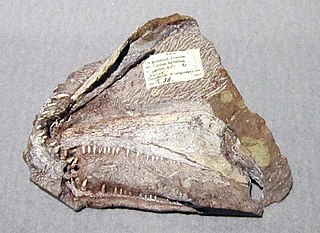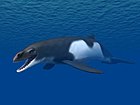
Plotopteridae is an extinct family of flightless seabirds with uncertain placement, generally considered as member of order Suliformes. They exhibited remarkable convergent evolution with the penguins, particularly with the now extinct giant penguins. That they lived in the North Pacific, the other side of the world from the penguins, has led to them being described at times as the Northern Hemisphere's penguins, though they were not closely related. More recent studies have shown, however, that the shoulder-girdle, forelimb and sternum of plotopterids differ significantly from those of penguins, so comparisons in terms of function may not be entirely accurate. Plotopterids are regarded as closely related to Anhingidae (darters) and Phalacrocoracidae (cormorants). On the other hand, there is a theory that this group may have a common ancestor with penguins due to the similarity of forelimb and brain morphology. However, the endocast morphology of stem group Sphenisciformes differs from both Plotopteridae and modern penguins.

Aetiocetus is a genus of extinct basal mysticete, or baleen whale that lived 33.9 to 23.03 million years ago, in the Oligocene in the North Pacific ocean, around Japan, Mexico, and Oregon, U.S. It was first described by Douglas Emlong in 1966 and currently contains known four species, A. cotylalveus, A. polydentatus, A. tomitai, and A. weltoni. These whales are remarkable for their retention of teeth and presence of nutrient foramina, indicating that they possessed baleen. Thus, Aetiocetus represents the transition from teeth to baleen in Oligocene mysticetes. Baleen is a highly derived character, or synapomorphy, of mysticetes, and is a keratinous structure that grows from the palate, or roof of the mouth, of the whale. The presence of baleen is inferred from the fossil record in the skull of Aetiocetus. Aetiocetus is known from both sides of the Pacific Ocean: it was first documented in Oregon, United States, but it is also known from Japan and Mexico. The genus is currently constrained to the Northern hemisphere and has little value in biostratigraphic studies of the Oligocene due to its limited occurrences across the Pacific.

Eogavialis is an extinct genus of eusuchian crocodylomorph, usually regarded as a gavialoid crocodylian. It superficially resembles Tomistoma schlegelii, the extant false gharial, and consequently material from the genus was originally referred to Tomistoma. Indeed, it was not until 1982 that the name Eogavialis was constructed after it was realised that the specimens were from a more basal form.

Gryposuchus is an extinct genus of gavialid crocodilian. Fossils have been found from Argentina, Colombia, Venezuela, Brazil and the Peruvian Amazon. The genus existed during the Miocene epoch. One recently described species, G. croizati, grew to an estimated length of 10 metres (33 ft). Gryposuchus is the type genus of the subfamily Gryposuchinae, although a 2018 study indicates that Gryposuchinae and Gryposuchus might be paraphyletic and rather an evolutionary grade towards the gharial.
Siquisiquesuchus is an extinct genus of gavialid crocodilian. It is known from cranial remains and a few postcranial bones found in Miocene-age rocks of the Castillo Formation in northwestern Venezuela.

Morrinhosuchus is an extinct genus of notosuchian crocodyliform from the Late Cretaceous Adamantina Formation of Brazil. It is known from a mandible and a portion of the front of the skull collected from the municipality of Monte Alto in São Paulo state. Morrinhosuchus refers to Morrinho de Santa Luzia, a hill nearby the collection site of the holotype, while luziae refers to the chapel of Santa Luzia, which is located on top of the hill.
Kuntinaru is an extinct genus of tolypeutine chlamyphorid armadillo which existed in Bolivia, during the Late Oligocene. It is known from the holotype MNHN-SAL 1024, skull missing the apex of the rostrum and the paratype MNHN-SAL 3, second skull missing the apex of the rostrum, recovered from the Salla Formation, Salla, Department of La Paz, Bolivia. It was first named by Guillaume Billet, Lionel Hautier, Christian de Muizon and Xavier Valentin in 2011 and the type species is Kuntinaru boliviensis.

Ymeria is an extinct genus of early stem tetrapod from the Devonian of Greenland. Of the two other genera of stem tetrapods from Greenland, Acanthostega and Ichthyostega, Ymeria is most closely related to Ichthyostega, though the single known specimen is smaller, the skull about 10 cm in length. A single interclavicle resembles that of Ichthyostega, an indication Ymeria may have resembled this genus in the post-cranial skeleton.

Llanocetus is a genus of extinct toothed baleen whales from the Late Eocene of Antarctica. The type species, Llanocetus denticrenatus, reached gigantic proportions, with the juvenile specimen reaching an estimated 8 m (26 ft) in length; a second, unnamed species, known only from three isolated premolar teeth, reached an estimated total body length of up to 12 m (39 ft). Like other contemporary baleen whales of the Eocene, Llanocetus completely lacked baleen in its jaws. It was probably a suction feeder like the modern beaked and pygmy right whales.
Tohoraata is a genus of eomysticetid baleen whale from the Late Oligocene (Chattian) of New Zealand. There are two recognized species, T. raekohao and T. waitakiensis.

Waharoa is a genus of eomysticetid baleen whale from the Late Oligocene (Chattian) of New Zealand. It was identified with the discovery of Waharoa ruwhenua by Boessenecker and Fordyce (2015), which added a new genus and species to a monophyletic family Eomysticetidae.

Horopeta is a genus of baleen whale from the Late Oligocene (Chattian) Kokoamu Greensand of New Zealand.

Coronodon is a genus of toothed (transitional) baleen whales from the Early Oligocene Ashley and Chandler Bridge formations of South Carolina. The genus contains three species: the type species C. havensteini, and additional species C. newtonorum and C. planifrons.

Mirocetus is a genus of archaic odontocete from the late Oligocene (Chattian) of Azerbaijan. Like many other primitive odontocetes, its classification has been fluid since its description.

Arktocara is an extinct genus of river dolphin from the Oligocene epoch of Alaska, containing one species, A. yakataga. Having been discovered in 25-million-year-old strata near the 60th parallel north, it is perhaps the oldest-known crown toothed whale and the northmost river dolphin discovered. It was a member of the now-extinct family Allodelphinidae, along with the genera Allodelphis, Goedertius, Ninjadelphis, and Zarhinocetus. It measured approximately 2.26 or 2.28 meters, comparable to its closest living relative, the South Asian river dolphin, which measures 2.4 meters (7.9 ft). However, the animal probably had an elongated beak and neck, so it may have been longer. The animal is known only from a partially preserved skull. Its ecology may have been similar to the modern-day Dall's porpoise, and it may have competed with contemporaneous delphinoids. Its remains were found in the Poul Creek Formation, which has also yielded several mollusk species.

Morenocetus is an extinct genus of primitive balaenid from the Early Miocene Gaiman Formation of Patagonia, Argentina.
Ronwolffia is an extinct genus of horned armadillo (Peltephilidae), distantly related to the modern species of armadillos and to the extinct glyptodonts. It lived during the Oligocene in what is now the Salla Formation in Bolivia.

Tonsala is an extinct genus of Plotopteridae, a family of flightless seabird similar in biology with penguins, but more closely related to modern cormorants. The genus is known from terrains dated from the Late Oligocene of the State of Washington and Japan.

Klallamornis is an extinct genus of Plotopteridae, a family of large, flightless birds related to modern cormorants, darters, gannets, and boobies. This genus included the largest North American plotopterids. Its remains can be found in Late Eocene to Late Oligocene rocks from the Makah Formation, the overlying Pysht Formation and the Lincoln Creek Formation of the State of Washington. During its existence, Klallamornis was the largest plotopterid on the North American continent. The first fossil remains attributed to the taxon were collected in 1983, although the genus wasn't described until 2016.

Olympicetus is an extinct genus of small simocetid toothed whales that lived during the Oligocene epoch in what is now the coasts of Washington, about 33.7 million to 26.5 million years ago. The type species is Olympicetus avitus, known from the littoral Pysht Formation and described in 2017. A second species, Olympicetus thalassodon, was named in 2023 and it is also known from this formation.



















